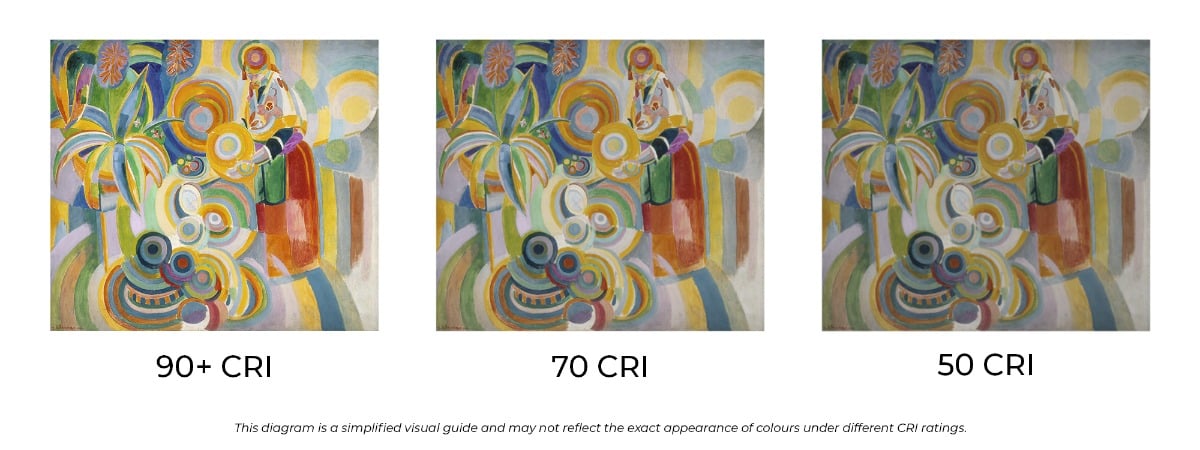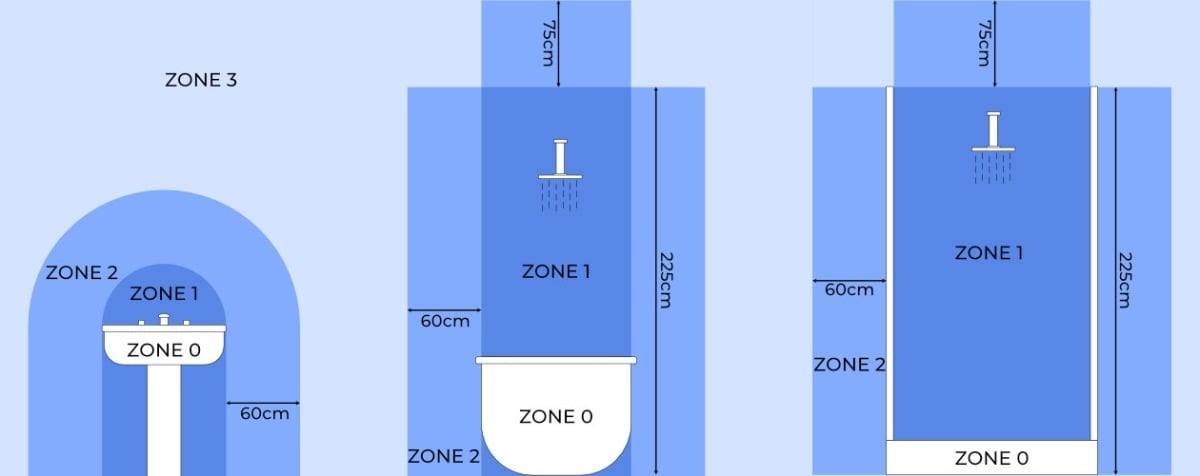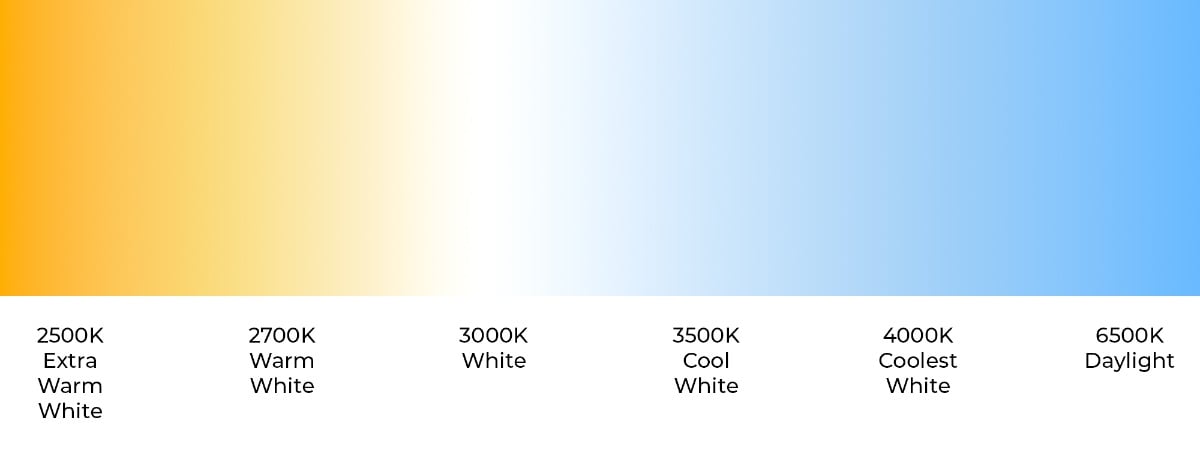A Lighting Specification Glossary for Design Professionals
Lighting is more than selecting a fixture and ticking the box, it’s about creating spaces that perform, feel good to be in, and meet rigorous technical requirements. Whether you're specifying for a workplace, boutique retail interior, or outdoor scheme, knowing your CRIs from your IPs ensures you don’t just get the look right, you get the spec right too.
This is our distilled guide to the terms that matter most on live projects, the ones that come up time and time again in conversations with clients, contractors, and consultants.
1. CRI, Colour Rendering Index

Artwork under the effect of varying CRI levels
Why it matters: CRI (Colour Rendering Index) tells you how accurately colours appear under a given light source, compared to natural daylight. Measured on a scale from 0 to 100, it’s essential for any space where materials, skin tones, or artwork need to look their best.
- 80+ is fine for circulation areas or basic task zones
- 90+ is a must for galleries, premium retail, restaurants, and high-end residential
We often see clients choose to overlook CRI when choosing lighting for material finishes, particularly wood or textiles, and end up with a flat or dull effect that doesn’t do the space justice.
Lighting Tip: Want timber to look rich and fabrics to pop? Go 90+ CRI every time.
Fixtures from brands like Bega, Vibia, Muuto, and Davide Groppi regularly feature high CRI values as standard, no need for compromises.
What is the best CRI for art galleries?
Aim for CRI 95+ for the most faithful colour rendering, especially when lighting oil paintings or colour-sensitive materials.
2. UGR, Unified Glare Rating
Why it matters: Glare isn’t just a nuisance, it’s a wellbeing issue. UGR is the measure of how much glare is perceived from a luminaire in its environment. In offices or workspaces, excessive glare can cause eye strain, headaches, and fatigue, leading to decreased productivity. It can undermine the entire lighting scheme.
- UGR < 19 is the target for desk-based environments, like classrooms and offices
- Avoid UGR > 22 in any setting with screens or direct line-of-sight fittings
A common mistake we see? Designers choosing downlights based on lumen output alone, only to find staff complaining of discomfort once installed.
Brands like Occhio, Foscarini, and Ledluks incorporate glare reduction into the design DNA of their products, balancing visual comfort with performance.
What’s the difference between UGR and lux?
UGR measures visual discomfort, while lux is about light levels. You need both to work in harmony.
3. IP Rating, Ingress Protection

Zone diagram for various areas of a Bathroom
Why it matters: The IP rating determines whether a light fitting can withstand dust, moisture, or direct exposure to water. It's absolutely essential for bathrooms, kitchens, and outdoor spaces.
- IP20: Standard for dry indoor zones
- IP44: Suitable for bathroom zone 2, or covered outdoor areas
- IP65/IP67: Required for direct rain exposure or areas near showers
- IP68: Fully submersible, essential for underwater lights in pools or ponds
Incorrect IP ratings can quickly lead to issues, particularly in outdoor or high-moisture areas. We regularly support projects where fittings have failed due to mis-specification, often because steam, splash zones, or weather exposure weren’t fully accounted for early on. This can lead to warranty concerns or costly replacements down the line.
Ranges from Bega, Marset, and Sammode are rigorously tested and beautifully made, so there's no need to sacrifice aesthetics for resilience.
“IP44 bathroom zones explained” is a common query. We recommend:
4. IK Rating, Impact Resistance
Why it matters: IK ratings are essential when specifying for environments where luminaires may be knocked, kicked, or tampered with, think public buildings, schools, stairwells, and car parks.
- IK07–IK10 is appropriate for high-traffic or vandal-prone zones
- IK08 is a solid middle ground for most commercial schemes
Clients often forget about impact resistance until fittings start to fail, especially at low-level wall mounting heights or exposed outdoor locations.
Need a bollard for a public plaza? IK10 should be your default. Bega and Bover's ranges include models specifically designed for this kind of robust spec.
5. Colour Temperature, The Kelvin Scale

Scale diagram showing the colour of varying Kelvin temperatures
Why it matters: Kelvin temperature refers to the warmth or coolness of light, and it directly influences the ambience and purpose of a space. Lower values = warmer, higher = cooler. Get it wrong, and the mood can feel jarring or uncomfortable.
- 2700K: Cosy and ambient, great for homes, restaurants, lounges
- 3000K–3500K: Neutral and welcoming, perfect for hotel lobbies, retail
- 4000K–5000K: Brighter and more functional, ideal for offices or kitchens
- 6000K+: Daylight-like, best for industrial, clinical or detail-critical areas
We often advise clients to mix colour temperatures strategically within the same project, for example, using 2700K in hospitality zones, but switching to 4000K in back-of-house or corridor areas where visibility matters more than mood.
&Tradition offers tuneable white options that allow for dynamic control across different temperatures.
Brands like Muuto and Vibia also offer versatile colour temperatures across their core collections.
6. Dimming Protocols, Ensuring Compatibility
Why it matters: Dimming isn't just about ambience, it’s often about compatibility, energy saving, and system integration. But with multiple protocols on the market, mismatches between driver, dimmer, and fitting are all too common.
- Mains Phase (Triac): Simple, common, but not always LED-compatible
- 0–10V: Analogue, requires dedicated wiring
- DALI: Smart, scalable, ideal for large or complex projects
- Casambi / Zigbee / Matter: Wireless flexibility for retrofits, smart homes, and connected control systems
We’ve seen projects run into problems late in the process when a decorative fitting turns out to be incompatible with the building’s dimming system. It’s the kind of avoidable issue that can impact both timelines and budgets.
Brands like Artemide, Lodes, and Occhio offer clear guidance on dimming compatibility, and our specification team can help you decode the jargon before it becomes a problem.
Always confirm control systems at the start of the spec process, retrofitting dimming is rarely simple or cheap.
7. Environmental Considerations, Bug & Bat Ratings
Why it matters: As planning rules tighten and awareness of ecological impact grows, bug- and bat-friendly lighting is becoming a core spec consideration, especially for outdoor and rural projects.
BUG ratings (Backlight, Uplight, Glare) help quantify how much light escapes a fitting in unwanted directions. Lower ratings, especially U0, reduce light spill, skyglow, and disruption to wildlife. Many of BEGA’s Dark Sky luminaires meet these standards, with full BUG data available in their datasheets.
Bat-friendly lighting goes a step further, requiring warm colour temperatures (≤2700K), zero uplight, minimal glare, and directional optics to avoid lighting up roosts or flight paths. Where possible, integrate timers, sensors, or dimming to reduce impact.
Need to meet dark sky or wildlife-sensitive requirements? Look to BEGA and Louis Poulsen for compliant solutions, or speak to our team for project-specific support.
Final Thoughts
These aren’t just technical definitions, they’re the essentials of good lighting design. Whether it’s achieving glare-free comfort in a workspace or avoiding the classic ‘wrong-IP-in-the-bathroom’ pitfall, these terms form the language of specification.
At David Village Lighting, our team works daily with architects, designers, and developers to help navigate these details, offering trusted guidance from first consultation through to final sign-off.
We don’t just sell lighting, we help you specify it with confidence.
Need Support with a Specification?
Whether it’s choosing a high-CRI wall light for a gallery project, understanding DALI compatibility in a mixed-use development, or finding the right IP-rated outdoor pendant, we can help.
Get in touch here


 Shop Lighting
Shop Lighting


 100% Authentic products
100% Authentic products Free delivery on orders over £100 (UK Mainland)
Free delivery on orders over £100 (UK Mainland) 14 Days Return Policy
14 Days Return Policy
 Overseas Shipping Available
Overseas Shipping Available
 Over 70 Designer Brands
Over 70 Designer Brands
 Excellent Customer Service
Excellent Customer Service 








